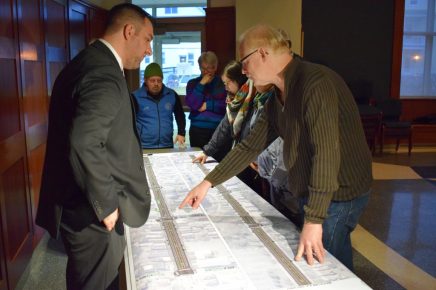By JONAS MILLER
Co-Executive Editor
A forum was held to introduce Phase Two of the plan to revamp Madison Avenue on Thursday evening at The College of Saint Rose. The project to turn what is currently four lanes into three will begin in July.
Phase one, which was completed in the summer of 2016, ran from South Allen Street to Partridge Street, and left one lane of traffic going in either direction with a dedicated turn lane in the middle of the road.
Phase two will pick up where the first left off, running from Partridge Street all the way down to Lark Street – a one-mile span of road.
Residents who attended the forum voiced concerns about the flow of traffic slowing dramatically because of the loss of lanes.
“I still need to get to work in the morning,” one resident said during the question and answer portion of the presentation. “I’m very thankful phase one of your project stops where it does.”
Bill Trudeau, coordinator of traffic engineering for the Albany traffic engineering unit, has been the leader of the project from the very beginning, and had nothing but positive words to describe the plan.
According to Trudeau, original designs for phase two were laid on in December 2016. He said that his team took what would usually be a year’s worth of work, and compacted it into four and half months.
He attributed the rush to two key factors: the success the city found in phase one, and necessary funding coming in much sooner, and also in a larger amount than expected.
“Lots of things fell into place,” he said. “The goal is to get lines on the road later this year.”
Jeff Pangburn and Mark Sargent, of Creighton Manning Engineering, presented the plan. They assured residents that although motorists might feel slightly more pain than pedestrians, the project will benefit the entire street when it’s all said and done.
“In the end it’s making Madison a better place for everyone that uses it, lives here, and works here,” Sargent said.
Melanie McCulley said she’s lived at the intersection of Madison and Willett Street for years and has seen first-hand the kind of vehicular congestion that can occur.
“One lane is almost always being used,” McCulley said. “The only way traffic can continue is by going into that second lane.”
A major proponent of the Complete Street Plan was to make Madison Avenue safer for pedestrians and bicyclists.
Bike lanes are a major component of the plan and when complete, they will run the entire length of the street. In order to make that a possibility, all bus stops along the street will have curbside stops, and pavement markings for bikes will be standardized.
Because of these changes, around 20 parking spaces will be lost, according to Pangburn. This is a change that McCulley and several other residents in attendance did not welcome.
“I’m very supportive of bicyclists. I bike myself,” she said. “But that area is very commercial,” referring to the intersection where Madison meets Lark Street and Delaware Avenue.
Despite living in the area for so long, McCulley said she very rarely see’s bicyclists. She attributed it to the busy nature of the area, and the weather fluctuating so frequently throughout the year.
Esther Thornton, president of the New Albany Neighborhood Association, has no concerns regarding the second phase of the revamping project.
She admits she was pleased with how phase one turned out, and said she was positive about the concept of phase two, though she did have some hesitation when it came to the new pedestrians crossings.
The new accessible pedestrian signals are lower to the ground and make noise, alerting citizens when it’s safe to cross. The flaw with the new buttons, according to Thornton, is that unless the button is pushed, the traffic signals do not change.
“It’s a long wait if you’re a pedestrian,” Thornton said.
In order for the project to acquire adequate funding, plans had to run through the City Common Council.
According to Pangburn, 80 percent of the project is being funded using federal money, with the City of Albany only funding five percent of the total project.
Common Council member Leah Golby, who represents the Pine Hills neighborhood, said almost all of the funding for the project is reimbursable. She’s also in favor of the plan, and has been since the project’s original conception.
“This project has been going on for over a decade,” Golby said. “I think it’s really important to finish the job.”
Golby’s neighborhood will see four city blocks’ worth of construction running from Partridge Street to South Lake Avenue.
“I have always thought it was a good idea to make Madison Avenue safer,” Golby said. “There are sections that I’m really looking forward to seeing more vibrant life on. It helps create places that people want to be rather than places that people just drive through.”
One aspect of the project that Pangburn went into detail on was a new video detection system for certain intersections. The technology, called Grid Smart, senses when vehicles move in an out of its detection zones, and will ultimately help the timing and flow of traffic, according to Pangburn.
Other major areas of improvement included in the design include pavement rehabilitation, sidewalk improvements, traffic signal upgrades and sign replacements.
Pangburn addressed the work currently being done between Partridge and Ontario as natural gas line replacements being installed ahead of the more serious construction that is to come.
For more information on phase two and other city projects, visit www.albany2030.org/complete-streets.


